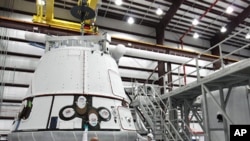The only spacecraft to travel to the International Space Station have been produced by nations, not commercial enterprises. But that could change if a previously postponed launch takes place at the end of this month, as planned. The Dragon would be the first commercial craft to ever fly to - and dock with - the ISS.
Bill Gerstenmaier, NASA's associate administrator for Human Exploration and Operations, said there is a "good chance" that the Dragon capsule, built by SpaceX, will be launched at the end of this month.
"There's still some more work we need to do, some more software testing that needs to get done, some other activities," said Gerstenmaier. "Everything looks good as we head toward the April 30 launch date, but I would caution us all that there is still quite a bit of work that needs to be done."
Gerstenmaier made the announcement during a news briefing at NASA's Johnson Space Center in Houston, Texas, Monday afternoon, a few hours after NASA managers, SpaceX officials and space station partners completed a flight readiness review.
The California-based company Space Exploration Technologies, commonly known as SpaceX, developed the reusable Dragon spacecraft and the Falcon 9 rocket. NASA is essentially the lead investor in this technology.
Gerstenmaier praised the partnership.
"I was very impressed with the discussion between the NASA teams and the SpaceX teams," he said. "When I hear the discussion back and forth, it's really one team. They're really focused on 'how do we deliver cargo to [the] space station? How do we get ready for this next phase?' And these teams have worked just phenomenally well together."
The main objectives for this flight include a fly-under of the station at a distance of 2.5 kilometers to show that the Dragon's sensors and flight systems are working properly. If everything appears to be in order, the space station crew will use the station's robotic arm to maneuver the spacecraft for a rendezvous.
Elon Musk is the chief executive officer and chief designer at SpaceX. He cautions that the Falcon 9 rocket and Dragon spacecraft are still relatively new technologies. Plus, Musk points out, the Dragon needs to meet up with an orbiting lab that is zooming around the Earth every 90 minutes.
"So you've got to launch up there, you've got to rendezvous and be tracking the space station to within inches really, and this is something that is going 12 times faster than a bullet from an assault rifle, so it's hard," said Musk.
It was in December 2010 that the Dragon spacecraft made history when it became the first commercially made space capsule to ever launch into orbit, circle the world, and successfully re-enter the Earth's atmosphere.
NASA plans to hold another assessment next week to determine if the Dragon is ready to make history once again.
News
NASA: 'Good Chance' for Historic SpaceX Launch April 30







